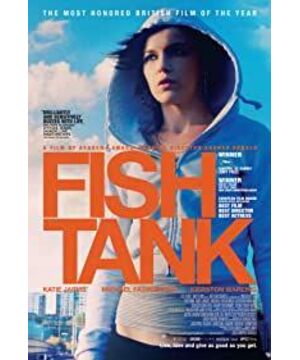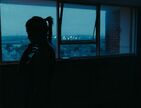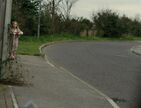Andrea Arnold is one of the most popular first-line directors in Britain today. Her short film "Wasp" won the 2005 Oscar for Best Short Story, and her debut in 2006 "Red Road" and "Fish Tank" released in 2009 both won a special jury award from Cannes in the same year. Before "Wuthering Heights", she always relied on her extremely personal film grammar to surround women who were not loved and traumatized, delicately and vividly portraying this group of marginalized figures in British society and the dramatic tension that happened to them. s story. This article will analyze the unique film grammar, narrative methods and themes of Andrea Arnold’s film creation timeline.
Unique movie grammar that cannot be copied
The reason why Andrea Arnold can create her unique film grammar is that most of her film themes and film protagonists are highly autobiographical. So she can explore and match the image method that suits her role in the film. In fact, in Arnold's debut work "Milk", the personal traces of Arnold's film grammar are not yet obvious, and it is more in line with the conventional video language of an industry-standard short film. A large number of fixed shots, close-up shots with a few slight pans, empty shots, and push shots constitute almost the entire film. In the first half of the film, a close-up of the female protagonist’s nipples is given a close-up of milk, echoing the ending of the female protagonist's use of sex and breastfeeding with teenagers to release the pain of losing a child. In Arnold's subsequent films, the first shot of almost all films is to show the first protagonist, and then let the audience take the perspective of the first protagonist and follow the rhythm of the story. Only the first shot of "Milk" is a close-up and empty shot of a fried egg. After the short film "Dog", the film was full of wide-angle lenses, and at this time the fixed lens was replaced by a hand-held shaking image, and the real life texture of the characters in the film was also captured more vividly. And from "Dog", you can see some similar shots also used in "Fish Tank". For example, when the female protagonist meets her boyfriend to cross the road, the middle shot-the subjective perspective of the female protagonist-the grand vision of the female protagonist crossing the road-walking with her boyfriend. same. The only difference is that because the male protagonist and the female protagonist in this set of shots in "Dog" were in a romantic relationship at the time, the camera will shoot from the front of the actor after the protagonist will go to the male protagonist to create a subjective shot; the similarity in "Fish Tank" In the group of shots, after the female protagonist will go to the male second, an objective lens with a subjective perspective of the female subject is taken from the side and back. This is because the female protagonist at this time is a strange acquaintance to the male second. The first shot creates a mentality for the male second to avoid the female protagonist while the female protagonist still actively pursues the state. In this shot of "Dog", the camera also began to move with the character's pace-the style of shaking the long lens and shooting took shape. After the female protagonist followed the male protagonist to a friend's house, the actor's performance was less restrained than the performance in "Milk", and was more flexible and more natural. Therefore, some people comment that Arnold's image style is documentary, which is exactly where it comes from. But in "Dog", the director's capture of the protagonist's emotions has not reached the level of detail in the later stage. In the director’s third short film "The Wasp", the image language extended the style formed by "Dog", and on this basis, added some sexually suggestive close-ups such as the lips of the heroine from the perspective of the heroine. The desires of the characters are strengthened and portrayed in a more delicate way. Since "The Wasp" portrays the role of a woman who is abandoned by her husband and still has a girlish heart to a certain extent with a group of children, the director's other film language is also formed here-by showing the interiors of the children's room The close-up shots to contrast the child’s inner innocence and beauty in a violent family growth environment where family love is fragmented.
"The Red Road" is Andrea Arnold's first feature film. The role of this film is relatively peculiar-the heroine is a middle class. But there is one thing in common with the protagonist of the previous film: the experience of bereavement such as the loss of her child or the abandonment of her boyfriend and husband. The expressiveness of "The Red Road" has also been enhanced in terms of audiovisual, such as low and gloomy tone, with a tendency of German expressionist photography style, a large number of Rembrandt lighting methods are used, and the atmosphere of the whole film follows the emotions of the heroine. Stuck in a state of grief over the past. In addition, the long lens and the people photographed in this film began to merge with the zoom. It was also from this film that Arnold’s iconic movie grammar began to mature: when the characters were walking, Arnold often used long-lens zoom to shoot the characters to replace the montage segmentation, so that the characters’ walking actions were consistent; when the characters were still standing still. When interacting with other characters in a certain place, the camera will use the front and back shot of montage to show. The audiovisual of "The Red Road" has a feature that Arnold doesn't have in other films, and the reason for this feature is also due to the personality of the heroine. In the scene of the dialogue between the heroine and her father-in-law in "The Red Road", there is a Wang Jiawei-style composition and position. Immerse yourself in the perception of your past memories. The relationship that alienates the characters is presented. It can also be seen that Arnold has an extremely meticulous grasp of characters. "Fish Tank" incorporates the main techniques of all previous films. For example, in the scene where Mia had a relationship with the heroine's mother and boyfriend, the hero was arranged to drink, which is consistent with the way the heroine drinks with the boy before the heroine finally has a relationship with the boy in the director's debut film "Milk". But in "Fish Tank", the technique of this scene is richer. In order to pave the way for the emotions between the characters, the director not only arranged for the male lead to drink, but also arranged for the female lead to dance, creating a picture of drinking for fun. The director arranged for this scene to take place at night, hitting a main light outside the window of the house, and using the backlight to shoot the heroine dancing, creating a blurred and romantic atmosphere. It makes the relationship between the two seem more logical. Since the heroine of "Fish Tank" is not as gloomy as the heroine of "Red Road", but has heroic, domineering and strong self-awareness, the daytime scenes of this drama increase, resulting in the overall picture quality returning to " The texture of "Wasp", such as the lighting is not as deliberately delicate and low-key as in "The Red Road", but uses both natural light and artificial lighting to express. While maintaining the iconic image grammar after the director’s mature style, "Fish Bowl" has used the classic composition techniques of Hollywood commercial films in some scenes more freely. For example, when expressing the love between the heroine and the heroine, the director used the composition method of intersecting the contour lines of the faces of the characters to convey a sexually suggestive look and feel. This technique once appeared in the classic film noir director John Houston's "The Hero" (1948). And when Mia's family and the male lead caught the fish, when Mia went to the toilet, the director used the translucent glass window like mosaic in the toilet to photograph the male lead outside. With the help of the windows on the scene as a performance element, it creates a mysterious atmosphere for the male protagonist at this time in Mia's eyes. The art of "Fish Tank" is also more refined. For example, in order to portray the female protagonist's mother after she becomes a mother, she still has the psychological characteristics of a princess. For the layout of the mother's room, pink and purple are used, and many cosmetics are placed, especially in front of the dressing table. The butterfly model of, which means that this mother with several children is very yearning for love. The subsequent "American Sweetheart" is a continuation of the director's style. The most significant difference is that the director used a very obvious filter effect to give the tone of the "American Sweetheart" a different kind of romantic atmosphere. And it became a road movie. In "Wuthering Heights", because the film is a commercial film adapted from a famous book, although the director continues to use her rich personalized imaging methods, the picture of the whole film is very refined. For example, the lighting is obviously in accordance with the industry industry. Standard sophistication to create. Department of road films. In "Wuthering Heights", because the film is a commercial film adapted from a famous book, although the director continues to use her rich personalized imaging methods, the picture of the whole film is very refined. For example, the lighting is obviously in accordance with the industry industry. Standard sophistication to create. Department of road films. In "Wuthering Heights", because the film is a commercial film adapted from a famous book, although the director continues to use her rich personalized imaging methods, the picture of the whole film is very refined. For example, the lighting is obviously in accordance with the industry industry. Standard sophistication to create.
The use of classic narrative methods
Arnold's films are prone to elements such as people who cannot be loved, single mothers and daughters who have to seek independence, revenge, and redemption. In the plot setting, the classic plot mode is often used, and the setting of the characters and the relationship between the characters also has the characteristics of melodrama. Therefore, at the narrative level, Arnold's films tend to be mainstream. The family environment of the characters in the film is often set up to be fragmented, so these characters are eager to find love to make up for their lack of family love. The heroines of "Fish Bowl" and "American Sweetheart" are even eager to make a living on their own. Whether it is the debut work "Milk", or "Fish Bowl", "American Sweetheart", "Wuthering Heights", a set of classic triangular or quadrangular relationships are set up between the characters, and drama is also produced from it. The previous analysis shows that the director is very good at capturing the inner emotions of the characters, so as to show the desires of the characters. The inner desires of these characters drive them to have strong external actions. For example, after the heroine in "Fish Tank" lost her friend, combined with the emotions accumulated by the incompleteness of her father's love for many years and the mother's peculiar way of discipline, she became emotional when she saw a locked horse and her desire for freedom, growth, and independence. , Vented by smashing the horse chain.
Based on this model of polygamy, stories often show the original environment of the characters first, which is also the cause of the drama. After taking the cause, the character who makes the first protagonist feel emotional will appear, and as the plot develops, the relationship between the two will continue to advance. But often, the first protagonist will get hurt in this relationship. In "Fish Bowl", the hero disappears after the heroine has a relationship with the hero, and then the heroine discovers that the hero has a wife and daughter, and he is a veritable scumbag. In "American Sweetheart", the heroine who the heroine falls in love with has an adulterous relationship with the second woman. In "Wuthering Heights", the heroine's beloved heroine marries his wife, and love is subject to strong resistance. As a result, these protagonists began their revenge behavior afterwards. For example, the heroine in "Fish Tank" almost drowned the hero's daughter. In fact, "Fish Bowl" has a typical three-act structure. If you add a title to each part of the film like Godard did, it will be roughly "Mia’s Love", "Mia’s Revenge" and "Mia’s Self growing up". Just like the redemption part at the end of "Fish Bowl", in the last paragraph of Arnold's film, these protagonists always wake up, find another exit to life, and get redemption, as if the last moment of darkness before dawn ushered in the dawn. The same is true of "Red Road", especially the last shot, which takes a panoramic view of the street, like a road to forgiveness. In this regard, the director’s narrative method is also in line with the mainstream Hollywood routines. Hollywood commercial mainstream movies are often in order to cater to the audience, and after the drama is pushed to the climax, it adopts a more warm and healing way to end, such as the ending of a family carnival.
Expressing themes in metaphors
The chained horse in "Fish Tank" mentioned earlier is actually a core symbol in "Fish Tank". The director is very good at setting a symbol throughout the film to metaphor the theme of each film. The horse symbolizes freedom in "Fish Tank". At first, smashing the horse chain is not only an outlet for the female protagonist to vent her emotions, but also a mouthpiece for meeting the male second. The final death of Ma indicates that Mia's relationship with the male lead will end (death) and bring a new beginning (growth). Another example is the title of the movie "Milk" itself is the core symbol of the entire film. In the film, milk is not the milk to be drunk, but actually refers to the milk that flows down from the heroine's breasts, and this milk always reminds the heroine of the pain of losing a child. Therefore, milk refers to the helplessness and vulnerability of a woman after the loss of a child, no matter from the physical level or the spiritual level.
Using a symbol that runs through the film as a clue, the theme used to express is often the growth of women in a patriarchal society and the reflection of reality by showing a certain group of marginal figures in the UK. Arnold is very loyal to herself, and her works are highly autobiographical. Arnold was born in Kent, England. Arnold's mother was only 16 years old when he was born. Later, his mother raised four children including Arnold as a single parent. Arnold began to pay attention to the black slave issue of human history when he was ten years old, and liked to recite Anne Frank's diary when he was a teenager. After graduating from high school, she worked as a dancer on a TV show. Later, she left Dartford and went to London, where she worked as a host and TV actor on a children's show for almost ten years. After that, she gained a lot of attention. . Later, the idea of becoming a director was born, so he went to the American Film Academy Los Angeles to study film and writing, and began his own career as a director. Arnold's original experience is not a special case in the UK, but a representative phenomenon that reflects the UK. The UK had one of the highest teenage pregnancy rates in Western Europe in some years. For every 1,000 girls aged 15 to 19, 31 were pregnant. Therefore, Arnold always creates a character in the film who grows up in a fragmented native family environment. The heroine of "Red Road" is relatively special. Her tragic experience is not the betrayal of her husband, but a traffic accident that caused the accidental death of her husband and daughter. That accident completely destroyed the heroine's happy life. Since then, the heroine lives in a state of gazing (monitor) at others. In "Fish Tank", the transparent glass fish tank is desirably from the life circle under the surveillance of countless eyes in society, where countless eyes have the meaning of patriarchal gaze. In "Fish Tank", it can be seen from the audiovisual language and the performance of the actors that the mother regards her daughter as a rival in love. Mia, who has never enjoyed his father’s love, fell in love with her mother’s lover. To some extent, Mia has become the male protagonist’s lover and the mother’s true rival. When she saw the true face of the male protagonist, the female protagonist tried to retaliate by hurting the male protagonist's daughter. But in the end, the heroine walked out of narrow vengeance, and the moment she rescued the girl also marked her own growth. When she was slapped in the face by the male protagonist, and in the process of chasing her dream, she discovered that the club recruitment turned out to be a stripper. The double blow of career and love made her fully awakened. All this is a mockery of the patriarchal society. The gaze theory was mentioned in Hegel's "Phenomenology of the Mind" in the early development process, and its connotation has been continuously enriched and extended under the research of Lacan, Alduse, Foucault and others. Later theorists began to study the theory of gaze from the perspective of gender. One view generally recognized in the academic circles is that women are objects viewed under the gaze of men, and women obey the patriarchal system. Obviously, this kind of gaze is the gaze of the male's own subjective consciousness, so the fish tank with special physical attributes vividly reveals the meaning of the distorted and deformed image produced by refraction. At first, Mia was caught in it. When she saw the reality clearly, she realized self-salvation. The director uses this to express that the stared women need to grow up to fight against the patriarchal society and get rid of their subordinate status. In the end, Mia explored the path of life with a boy who was still young and of the same age, and ushered in a normal road of love, a transformation from a cocoon into a butterfly. Arnold uses his delicate female perspective to show great concern for women. Even if the hero of "Wuthering Heights" is a man, But this man is incompatible with other men in the mainstream patriarchal society, does not have the general characteristics of men in the general patriarchal society, and belongs to the representative of the disadvantaged groups in the patriarchal society. And in order to strengthen the male protagonist’s weak characteristics, the director set the male protagonist’s race to be black. Judging from the plots of being abandoned, not getting love, revenge, etc., the male protagonist of "Wuthering Heights" is exactly the same as the female protagonists of Arnold's other films both in reality and in his mental journey.
Arnold's films have extremely high practical significance, which helps the audience understand and walk into these marginal characters, feel their breathing in real life and pay attention. More or less, these films have a certain vigilant effect on reality, such as the sense of responsibility for the child and the creation of the original family as the child grows up. Under the real portrayal and exquisite shaping, the audience can experience the hardships of a certain kind of people's livelihood firsthand, leaving the audience and the society endless thinking.
View more about Fish Tank reviews







